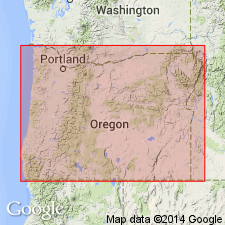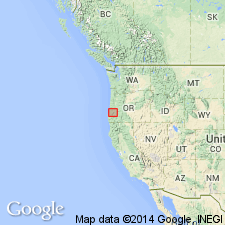
- Usage in publication:
-
- Flournoy Formation
- Modifications:
-
- Named
- Reference
- Biostratigraphic dating
- Dominant lithology:
-
- Sandstone
- Siltstone
- AAPG geologic province:
-
- Oregon-Washington Coast Ranges province
- Klamath Mountains province
Summary:
Type section designated as exposures along upper Lookingglass Creek in Flournoy Valley and between north edge of Lookingglass Valley and Tyee escarpment, Camas Valley quad, Douglas Co, OR. Reference sections designated as a nearly continuous exposure along Middle Fork of Coquille River from a point near east line of sec. 14, T30S R10W, westward to mouth of Rock Creek near Remote, also a well exposed section along a second Rock Creek, which lies south of Bone Mountain. Name first used by Baldwin (1973). Divided into two members (ascending): White Tail Ridge and Camas Valley Members (both new). Composed of rhythmically bedded micaceous sandstone passing upward into thin-bedded sandstone and siltstone. Thickness is 915 m. Unconformably overlies Lookingglass Formation (new). Underlies Tyee Formation. Age is middle Eocene based on biostratigraphic dating of microfossils.
Source: GNU records (USGS DDS-6; Menlo GNULEX).

- Usage in publication:
-
- Flournoy Formation
- Modifications:
-
- Revised
- AAPG geologic province:
-
- Oregon-Washington Coast Ranges province
- Klamath Mountains province
Summary:
Included as uppermost formation (of 3) in Umpqua Group. [Author discusses reasons for raising rank of Umpqua.] Shown in stratigraphic column at Middle Fork, Coquille River, Oregon. Overlies Lookingglass Formation (Umpqua Group). Underlies Tyee Formation. "No unconformity was observed by the writer between the Lookingglass and Flournoy..." p. 520
Source: GNU records (USGS DDS-6; Menlo GNULEX).

- Usage in publication:
-
- Flournoy Formation
- Modifications:
-
- Not used
- AAPG geologic province:
-
- Oregon-Washington Coast Ranges province
- Klamath Mountains province
Summary:
Flournoy Formation of Baldwin (1974) not recognized because unit is of limited extent. Part of rocks now included in Umpqua Formation as part of its White Tail Ridge Member and all of its Camas Valley Member. Rocks north of Coos Bay area assigned to Tyee Formation as interpreted principally from Wells and Peck (1961) and recognized in this report. [see author's Figure 1]
Source: GNU records (USGS DDS-6; Menlo GNULEX).
For more information, please contact Nancy Stamm, Geologic Names Committee Secretary.
Asterisk (*) indicates published by U.S. Geological Survey authors.
"No current usage" (†) implies that a name has been abandoned or has fallen into disuse. Former usage and, if known, replacement name given in parentheses ( ).
Slash (/) indicates name conflicts with nomenclatural guidelines (CSN, 1933; ACSN, 1961, 1970; NACSN, 1983, 2005, 2021). May be explained within brackets ([ ]).

